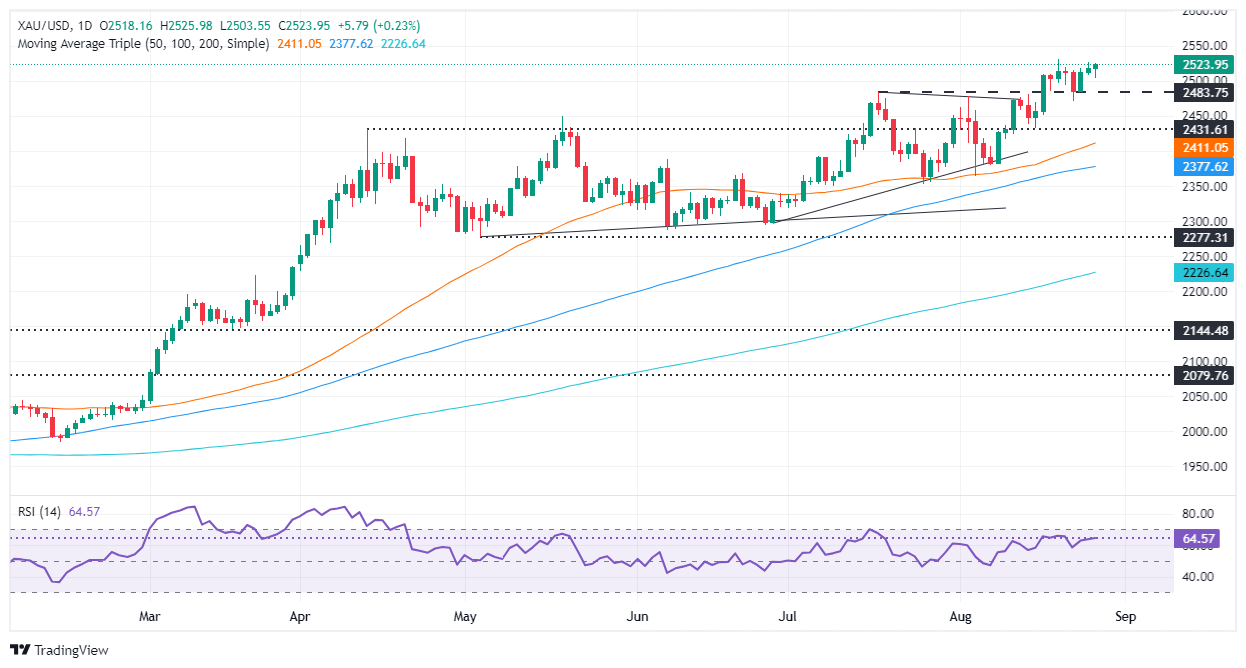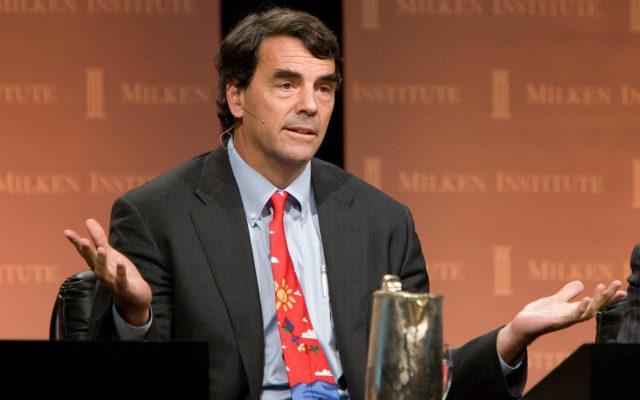- Gold rises amid risk-on mood, shrugging off strong US data as US Dollar hits 12-month low.
- Powell’s dovish comments keep US Treasury yields steady, putting pressure on the US Dollar and boosting Gold.
- Focus shifts to upcoming core PCE and employment data, crucial for Fed decisions; rate cut prospects boost Gold.
Gold prices advanced steadily during the North American session on Tuesday amid a risk-on environment and stable US Treasury yields. Investors shrugged off better-than-expected economic data from the United States (US), failing to prop up the already battered Dollar. XAU/USD is trading at $2,524 and gaining more than 0.20%.
The narrative in financial markets has remained unchanged since Federal Reserve (Fed) Chairman Jerome Powell announced last Friday that the time has come to lower interest rates. This caused US Treasury bond yields to fall and the US dollar to hit a new 12-month low, levels not seen since July 2023, according to the US Dollar Index (DXY).
The DXY is at 100.55, down 0.31%, while the US benchmark 10-year bond yield is at 3.829%, virtually unchanged.
American consumers were marginally optimistic in August, according to a survey by the Conference Board (CB). However, traders remain focused on Friday’s release of the core Personal Consumption Expenditures (PCE) Price Index, the Fed’s preferred measure of inflation, along with labor market data with the Initial Jobless Claims report announced on August 29.
This could be a prelude to the upcoming Non-Farm Payrolls report due to the Fed’s shift towards labor market concerns. The labor market remains healthy if the number of Americans filing for unemployment benefits is lower than estimates. Otherwise, the US Dollar could weaken further, creating a tailwind for Gold prices.
The Chicago Board of Trade (CBOT) December 2024 federal funds rate futures contract suggests investors are looking at 100 basis points of Fed easing this year, up from 97 on Monday. This implies traders are pricing in a 50 bps rate cut at the September meeting, though the odds of a reduction of that magnitude stand at 34.5%, according to the CME FedWatch tool.
Gold prices have been given a lifeline by rising tensions in the Middle East. The conflict between Israel and Hezbollah escalated over the weekend, and fears that the conflict could widen would be positive for the gold metal.
Daily market roundup: Gold price rises, ignoring consumer confidence data
- If US economic data remains weak, the bullish trend in gold prices is likely to persist, fuelling speculation about a further rate cut by the Fed.
- The U.S. Conference Board reported that consumer confidence for August came in at 103.3, up from an upwardly revised 101.9 in July and beating estimates of 100.7.
- Second quarter gross domestic product (GDP) figures in the second estimate are expected to improve from 1.4% to 2.8%.
- The Fed’s preferred measure of inflation, the core Personal Consumption Expenditures (PCE) Price Index, is due out on Friday. It is expected to rise to 2.7% from 2.6% year-over-year.
Technical Outlook: Gold’s uptrend remains intact as buyers target $2,550
The bullish bias in the Gold price remains, although the price action over the past few days shows that traders are reluctant to position themselves ahead of the release of the data from the PCE.
From a momentum perspective, the Relative Strength Index (RSI) is failing to break above its latest peak, contrary to the XAU/USD price action, meaning that a negative divergence could be brewing.
If XAU/USD falls below the current week’s low of $2,503 and $2,500, this would pave the way for a deeper pullback. The next support would be the July 17 high at $2,483, followed by the psychological mark of $2,450. Further downside lies the 50-day simple moving average (SMA) at $2,410, ahead of $2,400.
On the other hand, if gold prices break above the all-time high (ATH) of $2,531, this could sponsor a surge towards $2,550 before challenging $2,600.
Gold FAQs
Gold has played a pivotal role in human history as it has been widely used as a store of value and a medium of exchange. Today, apart from its luster and use for jewelry, the precious metal is considered a safe haven asset, meaning it is considered a good investment in turbulent times. Gold is also considered a hedge against inflation and currency depreciation as it is not dependent on any particular issuer or government.
Central banks are the largest holders of gold. In order to support their currencies in turbulent times, central banks tend to diversify their reserves and buy gold to improve the perception of the strength of the economy and the currency. High gold reserves can be a source of confidence in a country’s solvency. Central banks added 1,136 tonnes of gold worth about $70 billion to their reserves in 2022, according to data from the World Gold Council. This is the largest annual purchase on record. Central banks in emerging economies such as China, India and Turkey are rapidly increasing their gold reserves.
Gold has an inverse correlation with the US Dollar and US Treasury bonds, which are the main reserve and safe haven assets. When the Dollar depreciates, the price of Gold tends to rise, allowing investors and central banks to diversify their assets in turbulent times. Gold is also inversely correlated with risk assets. A rally in the stock market tends to weaken the price of Gold, while sell-offs in riskier markets tend to favor the precious metal.
Gold prices can move due to a wide range of factors. Geopolitical instability or fears of a deep recession can cause the price of Gold to rise rapidly due to its status as a safe haven asset. As a non-yielding asset, Gold prices tend to rise when interest rates fall, while rising money prices often weigh down the yellow metal. Still, most of the moves depend on how the US Dollar (USD) performs, as the asset is priced in dollars (XAU/USD). A strong Dollar tends to keep Gold prices in check, while a weaker Dollar is likely to push Gold prices higher.
Source: Fx Street
I am Joshua Winder, a senior-level journalist and editor at World Stock Market. I specialize in covering news related to the stock market and economic trends. With more than 8 years of experience in this field, I have become an expert in financial reporting.








